Flute Wrap
The Flute Wrap in Field Linen is our definitive answer to, “Is it chilly or is it just me?” Effortlessly elegant, you’ll be happy to grab this perfect summer accessory from your beach tote or camp bag, just in time for the night’s fireflies or campfires!
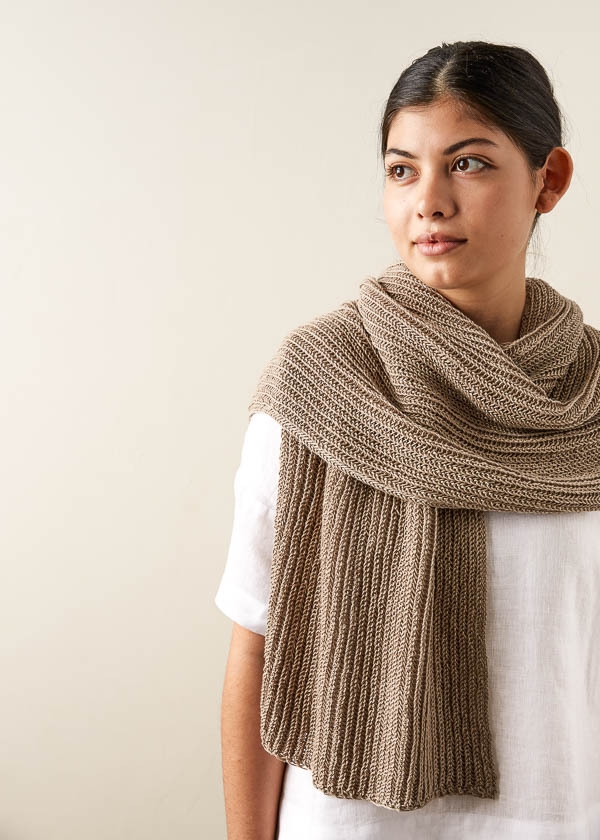
Although it may look like a rib, this stitch pattern is actually a fascinating loop-d-loop texture made by casting on the long way and working horizontally. The pattern is a one-row repeat with some fun extras, like double yarn overs and k2togs… Just to keep things interesting!
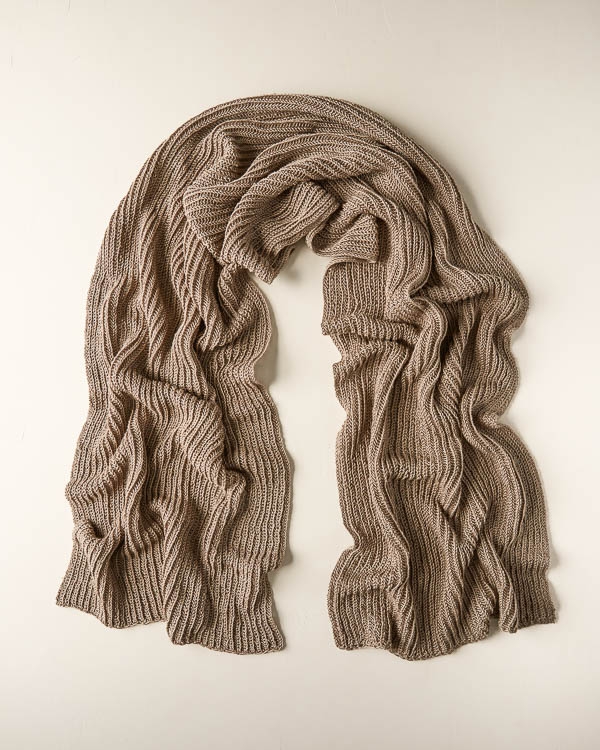
We knit up our Flute Wrap in our 100% linen Field Linen. We love that it’s temperature controlled, lustrous, and beautiful, and also that your Flute Wrap will only get softer and lovelier with age.
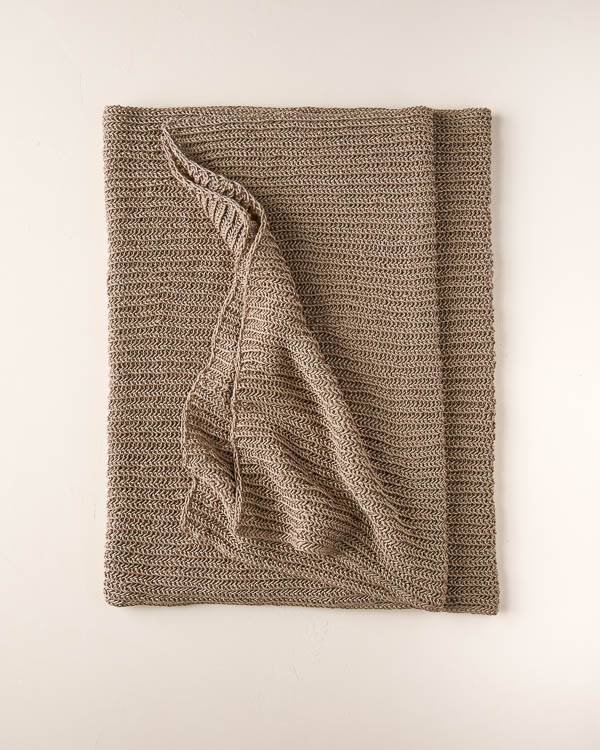
And when summer fades and the days shorten, don’t put away your Flute Wrap. It’s just as happy in an autumn chill as it is in a summer breeze!
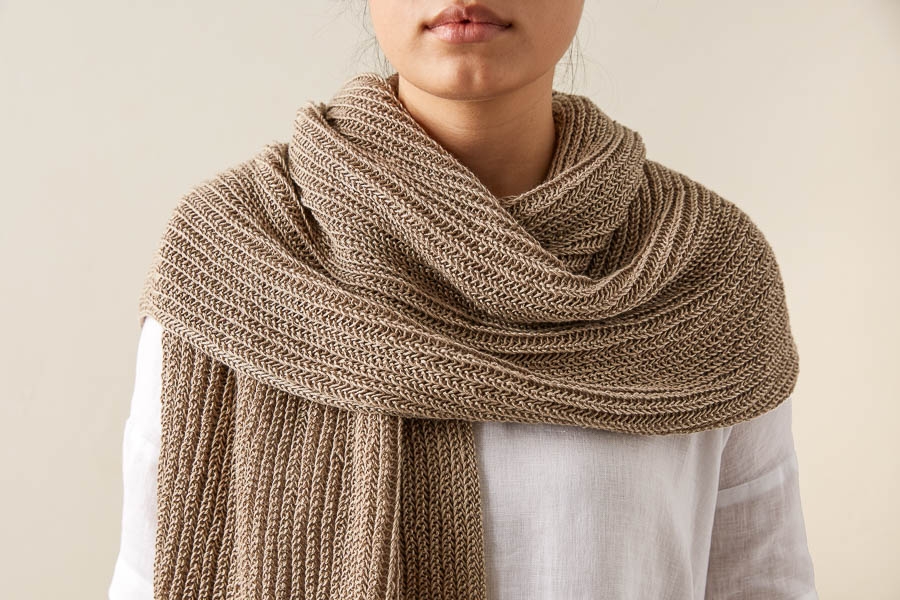
Designed for Purl Soho by Florence Spurling.
Share your progress and connect with the community by tagging your pics with #PurlSoho, #PurlSohoBusyHands, #PurlSohoFloteWrap, and #PurlSohoFieldLinen. We can’t wait to see what you make!
MATERIALS
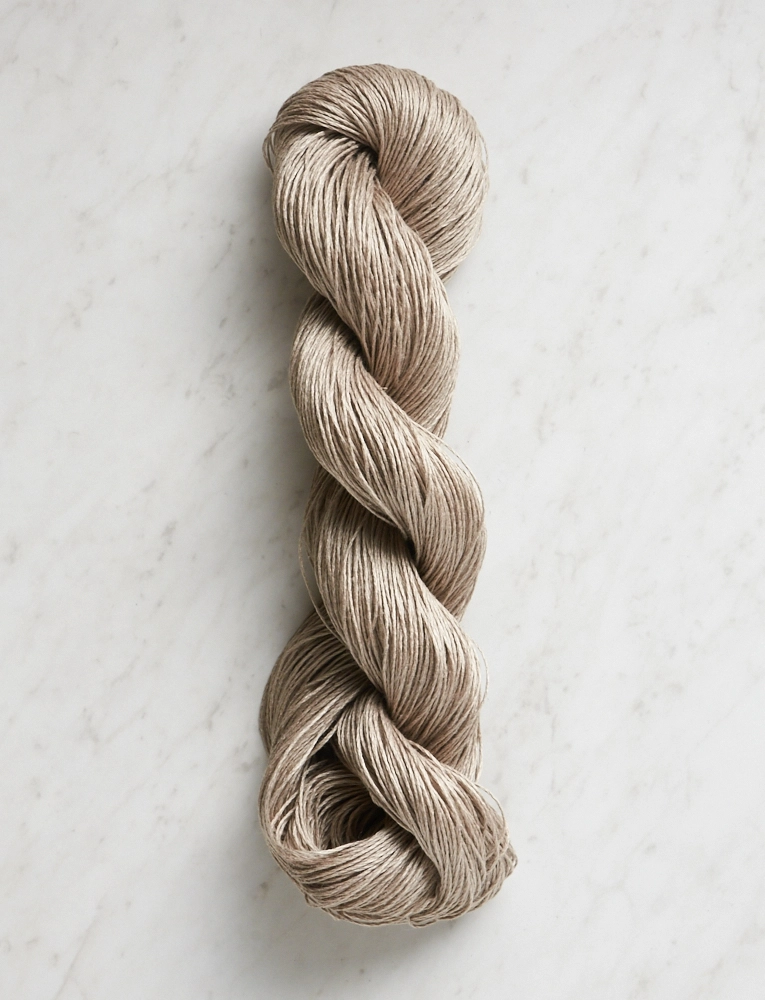
- 5 skeins of Purl Soho’s Field Linen, 100% linen. Each skein is 295 yards/ 100 grams; approximately 1475 yards required. We used the color Natural Flax.
- US 3 (3.25 mm), 47- or 60-inch circular needles
GAUGE
25 cast-on stitches and 20 rows = 4 inches in stitch pattern
SIZE
Finished Dimensions: 18 inches wide x 73 inches long
NOTES
First Loop vs Second Loop
In this pattern, you will create a “first” and “second loop” by wrapping the yarn twice around the needle when you make a knit stitch (kind of like a double yarn over). The two loops will inevitably get a little mixed up and crossed over each as you work, but that’s okay! Just keep in mind that the “first loop” is the one that comes up from the next stitch of the previous row, and the second loop is the loose strand that follows it.
Number of Stitches
You can work this pattern over any number of stitches.
PATTERN
Using a basic Long Tail Cast On, cast on 455 stitches. TIP: Place a marker or piece of scrap yarn every 50 stitches, so when you lose count, you won’t have to recount from the beginning! Remove the markers when you work the first row.
Set-Up Row: Slip 1 knitwise with yarn in back (wyib), k1, *k1 (wrapping yarn twice around needle), repeat from * to last stitch, p1. [907 stitches]
Row 1: Slip 1 knitwise wyib, knit first loop of next stitch (leaving second loop on needle), *knit first loop of next stitch together with second loop of previous stitch (wrapping yarn twice and leaving second loop of next stitch on needle), repeat from * to last stitch, p1. [907 stitches]
Repeat Row 1 until piece measures 18 inches from cast-on row.
Next Row: Slip 1 knitwise wyib, knit first loop of next stitch (leaving second loop on needle), *knit first loop of next stitch together with second loop of previous stitch (wrapping yarn once and leaving second loop of next stitch on needle), repeat from * to last stitch, p1. [455 stitches]
Bind off loosely knitwise.
Weave in ends and block as desired!
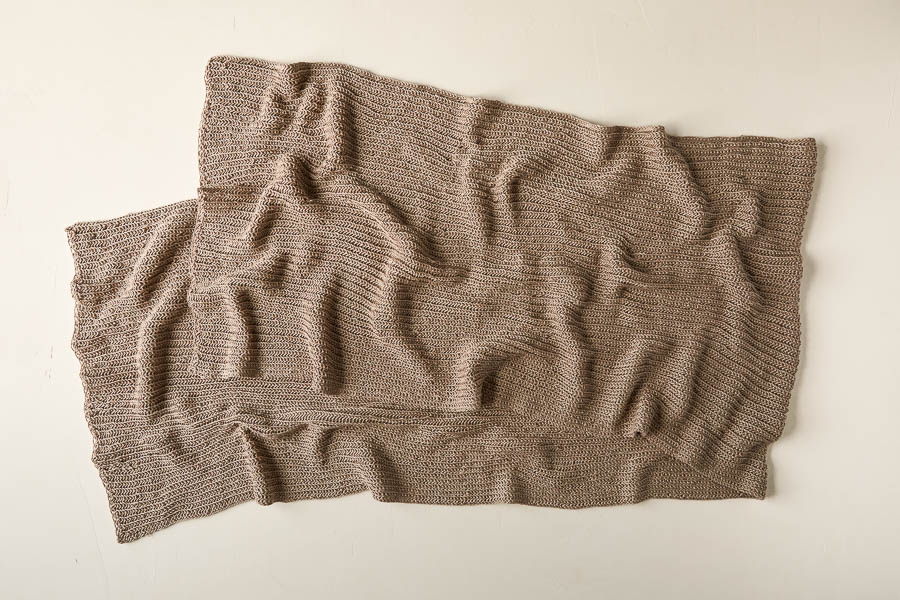

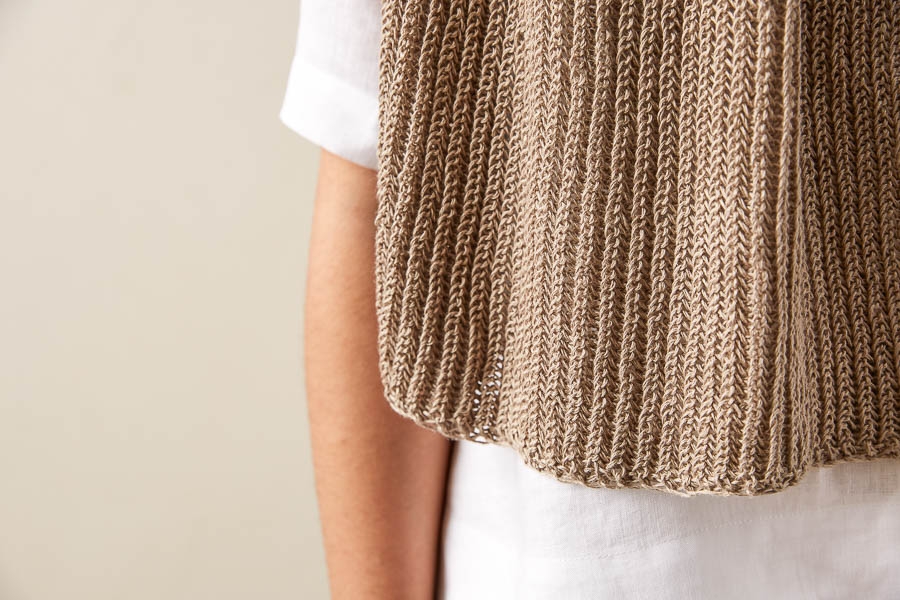

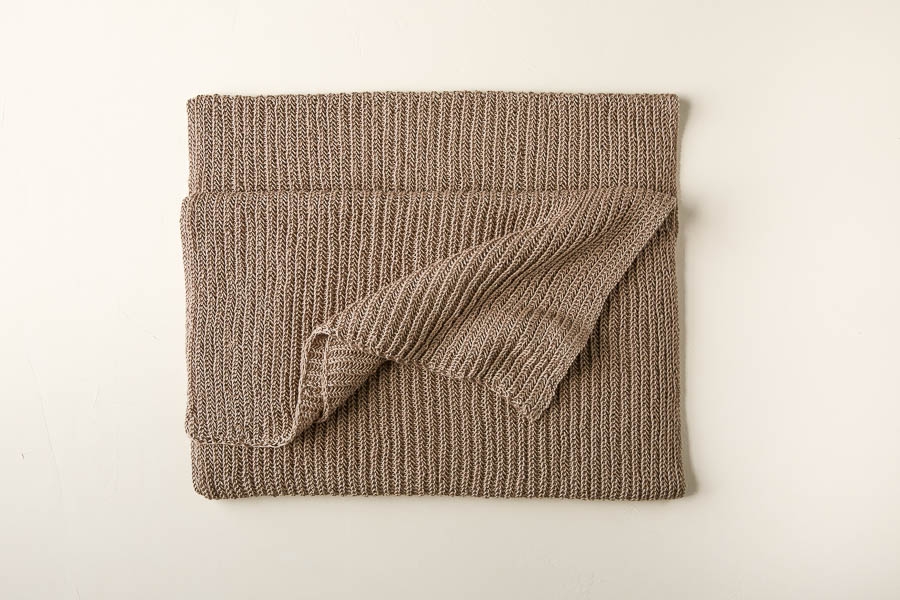


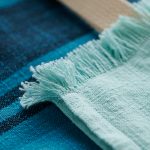


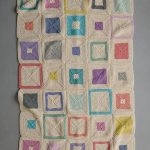
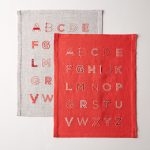
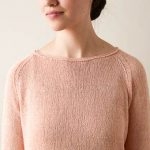
I’d like to crochet a wrap in linen or linen quill. Can you tell me how many skeins I would need to do this in double crochet?
Hi Amy,
Thanks for reaching out! This will certainly depend on your gauge and how large you would like to make your wrap! For our Granny Stripe Scarf, we used approximately 1250 yards of fingering weight yarn to yield a 10 x 65 inch scarf or wrap. This would be a good way to gauge how much yarn you would need. For example, if you would like a wrap the same size as this one (18 inches wide x 73 inches long), you would need approximately 2500 yards of Line Quill (6 skeins) or Field Linen (9 skeins).
I hope that this helps!
Cassy
Hi, really like this. I have lots of fingering weight yarn. How do you think hat weight would work? Or sport weight? Thanks.
Hi Maricia,
Thanks for reaching out! The lovely Field Linen that we used here is a fingering weight yarn! You can easily substitute any fingering weight that you like here. You will need roughly 1500 yards to get the size that you see here. As with any substitution, you will want to knit a gauge swatch to ensure that you get gauge and a pleasing fabric. You can always go up or down in needle size easily and adjust your cast on! This stitch pattern works over any number of stitches!
Best,
Cassy
I have knitted up some of your patterns and loved each and every one of them. I would like to know if this could be done using your Purl Soho Linen Quill. Keep up the great patterns.
Hi Denise,
Thank you so much for your very kind words! I think that this wrap would be lovely in Linen Quill! You will need 4 skeins!
Best,
Cassy
Pattern Directions seem confusing re: loops ???
Short Video would be brilliant.
Thank you –
Hello Martha,
Thank you for your interest in this pattern! While we do not currently have the resources for a video tutorial I will certainly pass along your suggestion!
Happy knitting!
-Marilla
Hi Martha,
I saw your message here and wanted to reply and say that I too am having the same issue with the pattern. It’s confusing and I’m hoping Purl Soho or perhaps someone who is knitting the pattern could post a video on YouTube! (Please 🙂
I would love to make this but the pattern, at first reading, looks rather fiddly. Can you suggest another pattern that would work with this yarn? Thanks!
Hello Bonney,
Thank you for reaching out! I would recommend looking at our Light + Shadow Wrap which is also knit up in our beautiful field linen, but is a bit more of a tv watching project. 🙂
Happy knitting!
-Marilla
Love the look of this Flute Shawl. Am having some difficulty eating going. Is there a video perhaps to show the pattern stitch? Also a close-up of the stitch would be helpful, as well. Thank you.
Hello Katrina,
Thank you for reaching out and for your suggestion- you are not alone. I will certainly pass along your request!
Happy knitting
-Marilla
Hi,
I love the patern but I have a doubt: 455 stitches for 18 inches. Is it right?
Thanks.
Hello Beatriz,
Thank you for reaching out- this is a great question! Your are absolutely correct, however you are actually casting on long ways so the 455 stitches is for 78″ and not 18″.
Happy knitting!
Marilla
I’ll admit that I do have problems, at times, visualizing a pattern. Do I understand correctly that the wrap is knitted lengthwise with the first and last row half the width of the remainder of the wrap? I have five scenes of linen quill and thought this would really look nice. Thank you!
Hello Eileen,
Thank you for reaching out! You are correct, the wrap is knit side to side rather than bottom to top. You cast on and off half the stitches, because you do not have your extra wraps which you add in your set up row.
I hope this helps and happy knitting!
-Marilla
I remember doing a long-tail cast on years ago, and had difficulties with how long the second tail should be — and had to go back a few times — so I never ever have done another one. Would you please put in the instructions about how long of an extra piece of yarn is needed — if that makes sense — I know it’s not a separate piece of yarn, it’s just from the same skein. The memory of that frustration has kept me from some very nice patterns — including this one … Thank you, Cassy, for any help you may give.
Hello Janice,
Thank you for reaching out! You are not alone in this frustration, I to have had to re-start a cast on due to a tail miscalculation. As a good general rule you want the tail to be three times the width of your project this means that for this tail it will need to be approximately 200″ or about 19 feet.
Happy casting on!
-Marilla
Hi! I’ve had the same frustration with long-tail cast-on many times, so since this was such a long cast-on, I did a trial to see how many stitches I could cast on with 24 inches. Based on that, I figured I would need about 45 feet, so I actually pulled 50 feet to be safe. I just finished casting on, and I had 6 feet left, so I used about 44 feet. I highly recommend the trial cast on!
Hi Joan,
Thanks for the great tip! I also recently discovered this trick to estimate how much yarn to leave for a long-tail cast on and it hasn’t failed me yet! Another method you can try if you have a very large number to cast on is to cast one with two balls of yarn at once – tie the ends of two balls of yarn together with a temporary slip knot, use these two ends to cast on, and then cut one ball of yarn off and remove the slip knot when you are ready to start knitting. It does create two extra tails to weave in, but you are guaranteed not to run out of yarn for your cast on with minimal waste!
Best of luck and happy knitting!
Julianna
Looks positively lovely. I work Portuguese style so purling is my preference – if I switch the knit to purl – and continue as per pattern – will the result be the same? Thanks
Hello Edith,
Thank you for reaching out! This should work beautifully and come out the same. I would knit up a practice swatch before jumping in for the loop stitches.
Happy knitting!
-Marilla
This looks lovely! Could you recommend the number of skeins I would need of Cattail Silk?
Thank you!
Hello Kendra,
Thank you for reaching out! You will need three skeins of Cattail Silk to complete this project.
Happy knitting!
-Marilla
I can usually understand your instructions but what does this mean? “knit first loop of next stitch together with second loop of previous stitch (wrapping yarn twice and leaving second loop of next stitch on needle)” If you’ve already knit the first loop, what does the beginning of this instruction refer to? Do you put the stitch you just made back on the left-hand needle and work it like a k2tog? And what exactly are you leaving on the needle?
Hello Tracey,
Thank you for this excellent question! After you have done your foundation row you will have two stitches for every cast on stitch (except for your first and last stitch). After you have slipped your first stitch of your “Row 1” you will knit the first loop of your next stitch (which has two loops because of the foundation row) THEN you knit the second loop of this stitch together with the first loop of the next stitch (yes, like a k2tog) but when you insert your right needle into these two stitches you wrap your working yarn twice rather than once like you would with a regular knit stitch ( just like you did in the foundation row). I know this is a wordy explanation, but hopefully it gives you a little bit of clarity. Please let me know if I can further clarify anything for you!
Warmly,
Marilla
I love the pattern, but can’t quite wrap my head around the stitch. Would it be possible for you to put up a video of the stitch? Thanks, Georgia
Hello Georgia,
Thank you for reaching out! You are not alone in your suggestion, I will add your request for a more extensive discerption of this stitch!
Warmly,
Marilla
Oh, wow, as usual, you have given us, literally, a SUPER cool pattern! This is the coolest stitch EVER! And, I hate seeing so many people struggling with it, because it is SUPER simple, and the instructions are spot-on, clearly and perfectly written. I have been knitting about 3 years, I think, so I am no expert by any means. Thank you so much for your never-ending inspiration!
What is the advantage of looping? Can one just knit and purl every other row? Is there,a simple version? I had to have another back surgery this past January which has left me with little to no desire to knit-which is awful because I have loved knitting so much and have enough yarn to stock my own store.
I’m adrift. Can y’all give me some help…and advice? I have so loved all things creative; most all mediums. A, unfortunately, my taste leans toward the best and most elegant, room brings me back to your site, every time!!!
I so love your site…
Thanking all of you, in advance.
Respectfully,
Karen P Hardy
Hi Karen,
Thanks for reaching out! We are so sorry to hear about the lack of desire to knit. The looping hear creates a very different texture to standard knits and purls. The texture here is quite a bit different to that of other patterns that we have made. However, if you are looking for something that could have a similar feel, the mistake rib would be a good alternate!
Thank you so much for your very kind words and we hope that we are able to spark your knitting itch!
Cassy
Casting off: do I cast off 455 stitches individually (i.e. loops are cast off)? Just need to check that.
Hi Katharine,
Thanks for writing in! You should be casting off each stitch individually knitwise, just as you normally would, without working any stitches together or wrapping any extra times, as we show in our Basic Bind-Off tutorial.
I hope that helps!
Julianna
Hello. Looks beautiful! But I’d like to make it a little shorter, maybe 60″. In multiples of what numerous should I cast on? Many thanks!
Hello Holly,
Thank you for reaching out! This stitch can be worked over any number of stitches. For a 60″ wrap I would cast on approximately 375 stitches.
I hope this helps and happy knitting!
-Marilla
Super! Thanks!
I want to try this pattern with cashmere or mohair yarn for winter. Which yarn is more suitable to this pattern?
Hello April,
Thank you for reaching out! I think Mohair might be to fluffy for this project. I think this wrap would be stunning in Jade Sapphire’s 2 ply Cashmere.
Happy knitting!
-Marilla
Thanks for the information
Hi,
I have 2 Skeins of the Black Willow Linen Field so thinking to buy more, do you think this wrap would look nice in that color or is it more suited to a single solid color?
Thanks
Melissa
Hello Melissa,
Thank you for reaching out! This is a great question, I think it could look cool, but you will loose some of the details of the stitch. I would knit up a little swatch and see what you think before jumping in.
I hope this helps and happy knitting!
-Marilla
Thanks for the stuff
Hello there, I recently started this pattern and I find as I am knitting, the yarn is splitting. My best guess is that this is due to a combination of my knitting style and the twist of The Field Linen, but I’m not quite sure. Any suggestions to prevent this? I’m finding it hard to distinguish between the loops with the split.
-Johanna
Hi Johanna,
Thanks for asking about this! It could be a number of factors, knitting style or yarn twist are two of them. I find sometimes when knitting with plant fibers or even just more slippery yarns that I have to move away from my usually preferred pointy needles and use needles that are less likely to split the yarn. Working with linen is definitely a different experience than working with wool, and sometimes the type of needle you use makes a big difference in working with different types of yarns. I hope this helps!
Best,
Cassandra
What level of knitting pattern is this? I’m a beginner and would like suggestions on patterns from your site. I purchased the beginner’s kit and loved it!
Hi Stacy
Thanks for writing in! We don’t rate our patterns for difficulty, because we want to encourage everyone to feel free to try things that are “too hard” for them and discover that learning new techniques enriches the process of making! I would guess that this is an advanced beginner project if I had to rate it. The skills you would be learning are slipping stitches, creating yarn overs and knitting two together . This pattern also has you cast on a very large number of stitches. The Little Ladders Scarf No-Purled Ribbed Wrap or the Elementary Wrap are also great beginner friendly choices. Hope this helps and happy knitting!
Jessica
This has been a great pattern and I am looking forward to getting it off my needles to see the final product! Question about the cast off; should I bind off each individual stitch or bind off in the same manner as the working stitch, combining the two wraps of each stitch into one?
Hi and thanks for reaching out! Congratulations on your nearly finished wrap! In the pattern above, we have instructions for one final row to work before the bind off, which will have you knit the loops together as usual but not work the double wraps, so you can bind off normally after that.
Happy knitting!
Julianna
Hi — I’d like to use Field Linen yarn, and I like this pattern very much. However, I’m a somewhat beginner and a little intimidated by the instructions — won’t be sure I get it until I actually try. The “Light and Shadow” pattern is recommended as easier. If I went with that pattern and the color Flax, which other Field Linen color would you recommend? Another thought: How would Light and Shadow look with just one color?
Thanks for thinking with me.
Polly Rose
Hi Polly Rose,
Thanks for reaching out! Beginner or advanced, it’s always a good idea to try knitting a sample before embarking on a new project, so you could always try knitting the Flute Wrap stitch now using any scrap yarn you have on hand to see how it goes! This pattern works with any number or multiple of stitches, so I would probably cast on about 20 stitches for a practice swatch. If you decide to go with the Light + Shadow Wrap instead, I would recommend using Natural Flax along with Queen Anne’s Lace. You could certainly knit it in a single color if you prefer! The garter ridges would still provide subtle texture that would be understated and lovely.
Happy knitting!
Julianna
Row 1: Slip 1 knitwise wyib, knit first loop of next stitch (leaving second loop on needle), *knit first loop of next stitch together with second loop of previous stitch (wrapping yarn twice and leaving second loop of next stitch on needle),
Hello
I’m wondering if the “leaving second loop of next stitch on needle” means that both loops are left on the right needle.
Thanks!
Corinne
Hi Corinne,
Thanks for reaching out! Yes, that is correct, you will have two loops on the right needle!
I hope this helps and please let me know if you have any more questions!
Gianna
Hi,
Any tips on how to pick up the second stitch? I find that I can pick it up through the back loop no problem, but I’m really struggling to pick it up through the front loop since it’s just wrapped around the needle and there’s no leg to use to guide it. Thx in advance
Hi Remy,
Thanks for reaching out! In this stitch pattern, you won’t actually need to knit directly into the second loop. Since you’re knitting the second loop of the previous stitch along with the first loop of the next stitch, once you insert your needle into the first loop of the next stitch, the second loop of the previous stitch will go along with it. These two loops will be easily knit together if you aim for the front leg of the first loop of the next stitch only!
I hope this helps, but if you’re still running into problems, I’d recommend sending a photo of your work to customerservice@purlsoho.com. That way, we can better visualize what might be going on!
All the best,
Lili